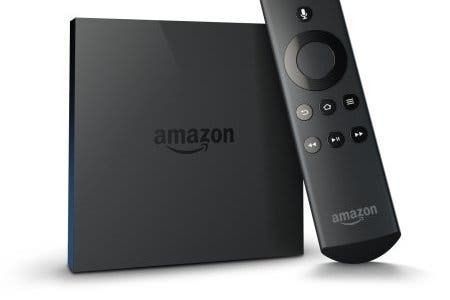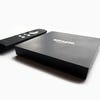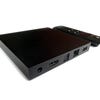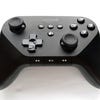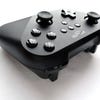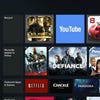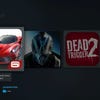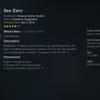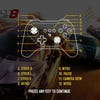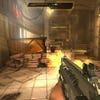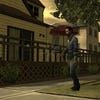Amazon Fire TV review
A challenger appears.
Released just last month in the US, Amazon Fire TV is a set-top media streaming box that has a firm foothold in the gaming camp. As well as offering hundreds of existing Android favourites, each playable with its custom gamepad, Amazon is also investing heavily in its own games studios to create exclusive titles - such as third-person shooter Sev Zero available at launch. At $99 the box is hardly going head-to-head in the living room space with the PS4 or Xbox One, but for the money could this offer the definitive Android gaming experience?
We're still waiting for an official UK release alas, but with a little help from our friends across the pond we're able get an early look at what the device can do. Out of the box, we're greeted with a tiny square tile - barely taller than an SSD, adorned in a black matte plastics on top, and with a glossy sheen reserved for its sides. Towards the rear of the device we get an HDMI out, optical out, a USB 2.0 connection, plus an Ethernet port for those who'd rather sidestep WiFi altogether - itself a viable option thanks to its built-in dual-band antenna.
Though surprisingly weighty, its low-key appearance sits well with just about any living room setup - its demure look also matched by an equally modest power requirement. Drawing just 6.25 volts through a supplied DC adapter, the device promises 1080p gaming courtesy of powerful mobile parts. This includes a quad-core 1.7GHz Snapdragon 300 Krait processor and Adreno 320 graphics chip - overkill for video streaming services such as Amazon's own Instant Video service or NetFlix, but a capable part for smartphone gaming.
The micro-console also boasts 2GB of RAM; standard for the latest wave of smartphones, and more than enough for juggling multiple low-footprint apps. Disappointingly, there's just 8GB of space to work with on the in-built storage front - a good chunk of which is reserved for the FireOS 3.0 operating system (Amazon's variant of Android 4.2.2). With no larger-capacity SKUs available, and the lack of an SD slot, this leaves us with 5.5GB of effective space for apps - a ceiling we hit regularly during our tests.
The OS is very reminiscent of its tablet incarnations, with movies, TV, apps and games all divided by a slick front-end menu. With no touchscreen interface to hand though, navigation is less intuitive when tapping the four-way controls at the centre of the supplied Bluetooth remote. Holding right to gradually scroll through a movie selection, for example, is a more long-winded, plodding affair than a sharp flick on a smartphone would have been. It's clear this UI needs a refresh in the move from tablets to set-top box, and this is especially evident when entering text.
Thankfully voice searches are a dependable alternative. All it takes is a pressing down of the microphone button at the top of the remote, and within two seconds - more often than not - the content appears. Its only downfall is with obscure names such as foreign-language films, but this is a far more convenient way to go than entering letters through a cumbersome scroll-wheel. Win or lose, voice control is surprisingly deft, and accurate enough to be worth a shot before resorting to a tedious plan B. It's perhaps a shame then that this method of search is only possible with Amazon's menu, and not rival apps such as NetFlix, or games requiring text entry.
The Amazon Fire TV gamepad, meanwhile, is a must if you want to experience the full breadth of the console's game catalogue (though we can confirm a wired 360 works just as well). It uses the 360 pad as a starting point for control layout, even down to the lettering on the face buttons, and makes use of matte plastics to produce a very solid feel overall. The shortcomings in polish amount to a sponginess in the d-pad, where the limited travel offers no real tactile feedback, and also an audible twang to the springs once its triggers are released. Ergonomically, the mould of its handles doesn't sit quite as comfortably in the palms as the 360 pad's - reminding us a lot of the OnLive pad's grip. Even so, despite a rather agricultural appearance, Amazon's effort sits among the better attempts at replicating a general design that has been continually fine-tuned by Microsoft and Sony.
This extra sets you back an additional $40, but is crucial for playing games like Sev Zero - as well as offering media controls at its front for rewind, fast-forward and play/pause. It's a disappointment to find no alternative to using two AA batteries, but in practise we haven't had to swap out the stock pair during over 30 hours of testing.
"Even on low settings Dead Trigger 2 easily betters Amazon's first-party effort Sev Zero in the performance stakes."
It's also worth mentioning that this is your sole contact point for most games, and attaching a mouse to the Fire TV's USB port simply doesn't work. It's a missed opportunity to broaden compatibility with touch-only compatible apps, as a floating cursor could have potentially stood as a makeshift replacement for touch controls. Meanwhile, keyboards can be connected to the device, but are only recognised for text input; the buttons becoming defunct on front-end UI and games.
So what about the games? Despite its investment in its own gaming studio, Sev Zero is Amazon's only exclusive launch title for the Fire TV - a third-person shooter that allows you to add and upgrade defences by switching to a top-down perspective. Unlike the many Android titles already available, being a first-party title gives it a unique chance to play to the new hardware's strengths. Sadly this opportunity is entirely floundered on a technical level. Performance levels are very wonky indeed as it seemingly strives for 60fps, with fluctuations between 30-40fps dominating the flow of play. It's also lacking the visual punch to show for this struggle, suffering from clunky running animations, deathly-dull arena and enemy designs, and a fixed internal resolution of 1280x720 with no anti-aliasing. All in all, Sev Zero is a rather disappointing use of the hardware and not exactly the best debut effort for a fledgling studio looking to make an impact in a highly competitive market.
Arcade zombie shooter Dead Trigger 2 proves that this needn't be the case. Based on the Unity engine, even on low settings this is among the best-looking games available for the Fire TV, and ousts Amazon's first-party effort handily. On high graphics quality we get a lock at 30fps with the game running at a full 1920x1080 - though frame-pacing issues mean the game's rapid camera motions feel far from fluid. Anti-aliasing is also entirely missing here, but the volume of enemies, use of bloom lighting, and detailed interiors make it a stand-out shooter in the visual sense. It's also impeccably controlled with the Amazon gamepad - one small grievance being that it requires manually mapping all buttons the first time you play.
Another great looker is racer Asphalt 8. Bolstered by beautiful city designs, the game is somewhat let down by choppy performance - capped at 30fps with "very low" graphics selected, and even then suffering from dips to 25fps. This is rendering at a resolution of 1728x972 too (working out at 81 per cent of the pixel throughput of 1080p) where the lack of AA causes noticeable aliasing as you cruise through Tokyo's neon streets. This is softened by bloom lighting and post-processing effects added on high settings; the only issue here being that the game perpetually runs at 20fps on this graphics preset. Much like Dead Trigger 2 the frame-pacing issue rears its head here, creating the impression of a far lower frame-rate even when it's holding at the 30fps line.
"Demanding 3D Android titles cause issues on the Fire TV, with frame-pacing one of the biggest problems, producing uneven gameplay."
Next up is Deus Ex: The Fall, a full-fat 1080p game according to our tests, and one that is once again lacking a much-needed coat of AA. Gamepad support is hugely appreciated when it comes to strafing and aiming at the same time, but with performance lurking between 20-30fps it's hardly the smoothest experience. Even when we get a lock on 30fps during cut-scenes, there's still the same nasty frame-pacing issue to contend with - where we see 130ms frame-pacing lag in its roughest patches. The game is also marred by disjointed character animations, woeful voice-acting, and a sickly posterisation effect which causes obvious colour banding to textures.
Taking a break from shooters, The Walking Dead: Season 1 runs at 1280x720 by default, with 60fps as the target. In line with Sev Zero, it struggles to nail this level of performance during the quick-time events that comprise a bulk of the experience, lurching down to 30fps during fast camera cuts. In fairness, as a point-and-click adventure this is not a complete deal-breaker, and the game's comic-book style visuals translate nicely to the big screen.
The last game we test is Minecraft Pocket Edition, which at last has the Amazon Fire TV outputting at 1920x1080 with no performance penalties. This simplified mobile version enforces an artificial limit in map size, but the core appeal is neatly adapted for the living room at a perfect 60fps. It's perhaps a shame a console of this spec hasn't received the same attention as the upcoming Vita version - a console with less power, but soon to be treated to something closer to the PC's unrestricted experience.
After playing this small smattering of games, it becomes apparent that most Android titles are still not available on Amazon's cut-down store. We're missing the likes of XCOM, Real Racing 3, and the excellent Ikaruga, all of which would be perfect candidates for the Amazon console's living-room vision, and would have given us a better outlook on the console's raw potential.
"In terms of the raw power on tap, 3DMark suggests that the Fire TV isn't far behind the much more expensive Madcatz Mojo and Nvidia Shield."
When it comes to benchmarking the hardware, this makes things tricky as neither GFXBench nor 3DMark synthetic tests are officially available - forcing us into the shadowy world of side-loading apps. With the ADB Debugging toggle enabled in the Fire TV's menu, the PC-side process is a tricky one involving installing package files using Android Debug Bridge over a shared network through command lines. Tellingly, after successfully installing it to the Fire TV, running GFXBench version 3.1 results in an impassable front screen that demands touch controls to continue. With no way to interact, we turn to 3DMark instead to put into perspective the power of the device.
Comparing results in 3DMark's Ice Storm test is revealing. Much like Mad Catz's Mojo and the Nvidia Shield, the standard 720p test gives us a nondescript maxed out result. Pushing it harder with the unlimited 1080p setting gives us an end score of 10729, however - falling just short of the 11237 and 11476 figures achieved on the Mojo and Shield respectively. This goes some way to show the extent of Fire TV's graphical strength, where as with any console launch line-up the hardware's true potential is far from being tapped into. That such a cheap console can come so close to rivals carrying price-tags of up to £180 is also pretty remarkable.
The video streaming experience is also worth touching on; depending on your bandwidth, Amazon Instant Video delivers high-quality video streams with greatly-reduced waiting times. The new ASAP algorithm aids this by downloading content intelligently in the background according to viewing habits. For example, if a series is being watched regularly, future episodes are cached to its storage in advance - avoiding the need to buffer the video on selection. We also notice a marked reduction in these buffer speeds when reading through a film's description page first, and then letting the video start.
In a curious twist, Amazon's rivals are also allowed to the party. NetFlix is readily available on the store, and US users have access to Hulu Plus and Crackle. However, these miss out on integral features such as voice search and ASAP, each running within their own bubbles while Amazon's store dominates the front-end.
"Voice recognition is a surprising high point in getting the most out of the new Amazon Fire TV."
Amazon Fire TV - the Digital Foundry verdict
As a first attempt at an all-in-one media device, Amazon's Fire TV micro-console is nicely positioned given the $99 price-point. Physically, the hardware sports a tidy, discrete design, and its components are more than capable for tackling video streaming services - with a handy voice recognition feature that helps hone in the content you're searching for. The FireOS 3.0 front-end is also smooth in operation and mostly easy to navigate by remote control, though the range of apps is unfortunately restrictive compared to other Android-based devices.
The gaming side is a disappointment though. Despite offering a robust 360-style gamepad for a little extra, this lack of selection makes the Fire TV very underwhelming as an Android gaming set-top box. Performance is part of the issue too: when it comes to playing titles at 1080p the console simply can't achieve even a smooth 30fps result in most cases. Dead Trigger 2 comes closest with playback being capped at that point, but much like Asphalt 8 and Deus Ex: The Fall we see frame-pacing issues causing unwanted stuttering in motion. It's not a pleasant experience, and as of writing, simply not worth if quality gaming is your priority over the other media-based aspects of the package.
Amazon's one and only first-party title, Sev Zero, doesn't save the day either, with its undemanding effects, wildly variable performance and 720p picture proving far from flagship material. Instead it's Minecraft Portable Edition that comes off as the closest the console has to a saving grace - a creative playground flawlessly adapted to work with the pad at 1080p60. It's a shame that Amazon's exclusive shooter doesn't draw out the strengths evident in synthetic tests, especially as the likes of Dead Trigger 2 outgun it for eye-candy while appearing on a multitude of other devices. Hope is on the horizon though, with an Amazon teaser trailer showing yet more first-party titles that could well make this hardware stand out in an already busy market.
